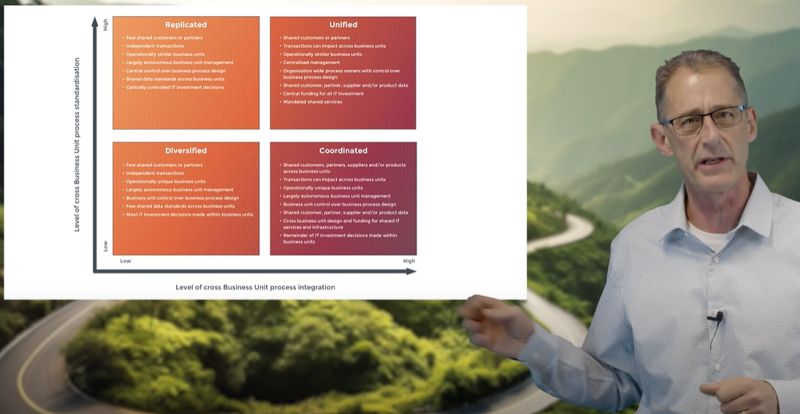At Fragile to Agile, we use the term “operating model” as defined in a seminal book from MIT, ‘Enterprise Architecture as Strategy‘. It elevates the term “operating model” beyond its typical MBA use to distinguish between an organisation’s operating model types. The key drivers for this differentiation are the levels of desired process standardisation and integration across business units.
Link to our video on the topic
Why Does the Operating Model Matter?
Technology Roadmap Development:
- Helps determine if capabilities should be standardised.
- Affects decisions during the current state assessment and target state definition.
- Ensures alignment with the organisation’s goals.
Operating Model Types:
- Diversified – No capabilities are standardised across business units.
- Replicated and Unified – Every capability is standardised.
- Coordinated – Some capabilities are standardised, others are not. This is the most common model we encounter.
Steps for Deciding on the Operating Model Type
Single Meeting Decision:
- Most organisations can decide on their operating model type in one meeting.
Coordinated Model:
- Requires further work to determine which capabilities are standardised.
- Capability model development is crucial to have meaningful conversations and enact decisions.
Facilitating the Decision-Making Process
Key Drivers Analysis: Discuss what key drivers mean for various capabilities.
- Example: If one business unit competes on cost and another on service, standardising the customer relationship management capability might not make sense.
Decision Implications: Go through the implications of standardising vs non-standardising.
- Standardised: One technology solution, single governance body, lower overall cost, but reduced agility.
- Non-Standardised: Different execution methods, independent governance, higher overall cost, but increased agility.
Practical Tips
- Most decisions (80%) are straightforward and can be made in a two-hour workshop with leadership.
- Time-box remaining decisions to two weeks. If no agreement is reached, the default is non-standardisation.
- Use overlays on the capability model to show standardisation across the organisation.
Conclusion: Understanding and deciding on your organisation’s operating model type is crucial for effective roadmap development and capability standardisation. By following these guidelines, you can facilitate informed decision-making and align your technology solutions with your business goals.
Interested in finding out more? Check out our video, and join the conversation on Linkedin …

